Special Report: Growth likely but future still uncertain for environmentally friendly additives
Dr. Neil Canter, Contributing Editor | TLT Tech Beat September 2018
Their fate depends on how quickly regulations take hold across the globe.

© Can Stock Photo / hKuprevich
KEY CONCEPTS
•
Environmentally friendly lubricant additives are widely available, but performance improvements are desired for antiwear additives, corrosion inhibitors, emulsifiers and EP additives.
•
Base stock selection impacts the types of environmentally friendly lubricant additives used.
•
Besides developing performance data, suppliers of environmentally friendly lubricant additives will need to produce data on biodegradability, aquatic toxicity and bioaccumulation as well as data required by specific governing bodies.
The growth of environmentally friendly lubricants is occurring in large part due to the implementation of regulations such as the European Union’s Ecolabel and the U.S. Department of Agriculture’s (USDA) Biopreferred programs (
1). Much of the development of environmentally friendly lubricants can be attributed to improvements in base stocks. Additives, which play a significant role in most lubricants, also have impacted the preparation of more effective environmentally friendly lubricants.
This article provides an update on the types of environmentally friendly lubricant additives available and the challenges faced by the lubricant industry in formulating with them.
Insight on environmentally friendly lubricant additives was obtained from representatives at the following:
•
ADM
•
Dow Chemical Co.
•
Functional Products, Inc.
•
Novitas Chem Solutions LLC
•
Novvi LLC
•
Polnox Corp.
•
RSC Bio Solutions
•
USDA
•
Zschimmer & Schwarz.
Key additives
STLE-member Dr. Ashok Cholli, president and CTO of Polnox Corp. in Lowell, Mass., says, “The selection of environmentally friendly lubricant additives is geared to address the performance issues related to the specific application and the stability or the quality of the base stock used. Key additives common to most formulations include antioxidants, corrosion inhibitors, antiwear additives, extreme pressure (EP) agents and emulsifier/demulsifier additives. For low-temperature applications involving vegetable oil base stocks, pour point depressants are required to enable the lubricant to remain in the liquid state under sub-zero temperature conditions.”
Karen Wagner, technical scientist for the USDA in Wyndmoor, Penn., says, “Additives such as isostearic acid serve to enhance the qualities of the base stock from undesirable changes and limit damage to surfaces in contact with the lubricant. The concentration and types of additives will vary according to the demands of the particular application and the type of base stock used.”
STLE-member Tyler Housel, CLS, head of the Lexolube Division of Zschimmer & Schwarz in Milledgeville, Ga., says, “Two of the most significant additives are glycerol monooleate and sorbitan monooleate. Both have a fantastic environmental profile, are biobased and have been used for decades in friction modifiers, emulsifiers and internal lubricants.”
Housel adds: “Butyl and isopropyl ester are adjuvants to improve lubricity in mineral oil-based formulations, and a wide variety of other biobased esters are similarly used as boundary lubricity additives in all types of lubricants and metalworking fluids (MWFs). A final example is serpentine (magnesium silicate hydroxide), a natural mineral that has been used as a lubricant additive. Both natural and modified versions are under evaluation to replace zinc dialkyldithiophosphates (ZDDPs).”
STLE-member Selim Erhan, global commercial development manager-Industrial Oils for ADM in Decatur, Ill., says, “Vegetable oils and derivatives are used as lubricity additives in water-based MWFs. Their large structure helps lower foaming, and their high surface attraction and thicker film formation are seen as positive attributes. But caution must be used because theses additives also are organic in nature and are susceptible to microbial degradation. Regular monitoring of the MWF is required to control the level of microbes such as bacteria and fungus.”
Daniel Vargo, senior research chemist for Functional Products, Inc., in Macedonia, Ohio, indicates that important additives are present in five categories. He says, “Corrosion inhibitors for ferrous alloys—for example, some metal sulfonates, amine phosphates and acidic long chain carboxylates, antioxidants such as arylamines and hindered phenolic compounds, antiwear additives such as amine phosphates, thickeners and pour point depressant such as polymethacrylates—are used in environmentally friendly lubricants.”
STLE-member Phil Levy, vice president, sales and marketing for Novitas Chem Solutions LLC in Houston, says, “Key ingredients are those that are sustainable (where possible) and exhibit low toxicity.”
Improving additive types
While there are a large number of additives available, performance improvements are desired in a few important categories such as antiwear and extreme pressure additives. STLE-member Paula Vettel, technical director formulations and regulatory at Novvi LLC in Emeryville, Calif., says, “The lubricant industry could use better antiwear, EP additive options. New additives must be ashless to meet the environmental specifications. It would be great to have Ecolabel-approved additive packages for all types of environmentally friendly base oils.”
STLE-member Dr. Larry Beaver, vice president, research & development of RSC Bio Solutions in Indian Trail, N.C., agrees and also believes that an improvement in corrosion inhibitors is required. He says, “Effective EP additives and corrosion inhibitors are both a challenge, particularly with respect to gaining The Center for Environment, Fisheries and Aquaculture Science (CEFAS) classification approval. We believe that EP additives stand out among all additive categories in requiring an upgrade.”
Housel, Levy and Vargo all agree that alternatives to additives containing heavy metals such as ZDDPs are required. Vargo adds, “Other examples where alternatives are needed include certain detergents such as heavy metal phenates and sulfonates and sulfurized additives including phenates and salicylates.”
Cholli says, “Addressing the eco-toxicity of the additives used is the No. 1 issue when formulating environmentally friendly lubricants besides other attributes such as no-bioaccumulation and biodegradation. In addition to using acceptable base stocks, each additive involved in the formulation also is required to be minimally toxic. Additives containing inorganic metal species other than calcium, magnesium, potassium and sodium are simply not suitable for use in environmentally friendly lubricants. Even some organic molecules have severe eco-toxicity issues and are not suitable for use.”
Erhan feels that emulsifiers for use in environmentally friendly lubricants need to be improved. He says, “There is a significant difference in HLB values for environmentally friendly lubricants compared to mineral oil-based lubricants. Current emulsifiers are mainly suited for use with mineral oil. Alternatives are needed for use with vegetable oil and ester base stocks in environmentally friendly lubricants.”
Challenging applications
Marine lubricant applications are among the most challenging, according to several of the respondents.
STLE-member Dr. Martin Greaves, research leader at The Dow Chemical Co. in Horgen, Switzerland, believes that water-based sub-sea hydraulic fluids used in open and closed loop subsea production systems to control the flow of oil or gas during exploration have to deal with severe operating conditions. “These fluids help by hydraulically controlling equipment from drilling on off-shore platforms,” Greaves says. “The fluids need to be protected from microbial infection but also need to have multi-metal compatibility and provide vapor phase corrosion problems. Sub-sea hydraulic fluids also should be compatible with a wide variety of elastomers and coatings. They need to be resistant to salt water, which can be very corrosive and stable for many years over the lifetime of the oil field project. Environmental regulations continue to tighten since fluid discharge can occur. Countries such as Norway and the UK set high standards of environmental performance.”
Vettel adds, “Ecolabel and the U.S. Vessel General Permit (VGP) regulations present big formulation challenges for environmentally friendly land and marine lubricants. There are requirements for biodegradability, bioaccumulation, aquatic toxicity and renewability, although the latter will be dropped in Ecolabel 2018. Ecolabel also restricts the use of additives with GHS hazard classifications. The Convention for the Protection of the Marine Environment of the North-East Atlantic (OSPAR) has similar requirements.”
Vargo says, “In marine applications, environmentally friendly lubricants must meet all regulations for discharge into water systems. Lubricants must be biodegradable, non-toxic, non-sheening and show equivalent performance compared to non-environmentally friendly lubricants.”
Wind turbines operate in environmentally sensitive locations on land and ocean. Housel says, “Wind gearboxes withstand severe and unpredictable loads, requiring long service life, and must perform under widely varying environmental conditions. Beyond that, wind turbines are highly visible; even a casual observer can see when the blade is not turning.”
Erhan raises the issue of oxidation, which is problematic for many environmentally friendly lubricants due to the high degree of unsaturation in the base stocks used. He says, “If the lubricant has to perform open to air for a long time (compared to a one-time-use lubricant), it will be necessary to take precautions to prevent oxidation that can lead to chain length deterioration and a loss of lubricity. The sections that break off during severe oxidation also will produce an acrid smell.”
Vargo says, “The vulnerability of vegetable oils to oxidation is primarily due to unsaturation. Typically antioxidants that are more effective and require higher treat levels can overcome this disadvantage. A formulator also must consider the polarity of additives with respect to the base oil. This can be a challenge. Vegetable oils have a high degree of polarity compared to mineral oils and polyalphaolefins (PAOs). Additives with a vastly different polarity than hydrocarbon base stocks may not be compatible or will lead to the formation of haze or sediment.”
Cholli indicates that current commercial antioxidants are “sacrificial” and simply take the hit for the material they are protecting against oxidation, which renders them inactive. He says, “We have developed an alternative technology known as a DT-mPM-based antioxidant that uses multiple antioxidant ‘warheads’ with a unique regenerative mechanism to protect and sustain the useful life of various materials. The continuous regeneration (a few times) of one warhead with the assistance of its second antioxidant warhead increases its useful life in the battle against the material’s thermo-oxidative degradation process.”
Figure 1 shows a thermo-oxidative stability study using the pressure differential scanning calorimetry procedure (ASTM D6186) where canola oil formulated with the DT-mPM-based antioxidant exhibits comparable performance at a 0.75% treat rate to a commercial antioxidant used at four times the treat rate (3%).
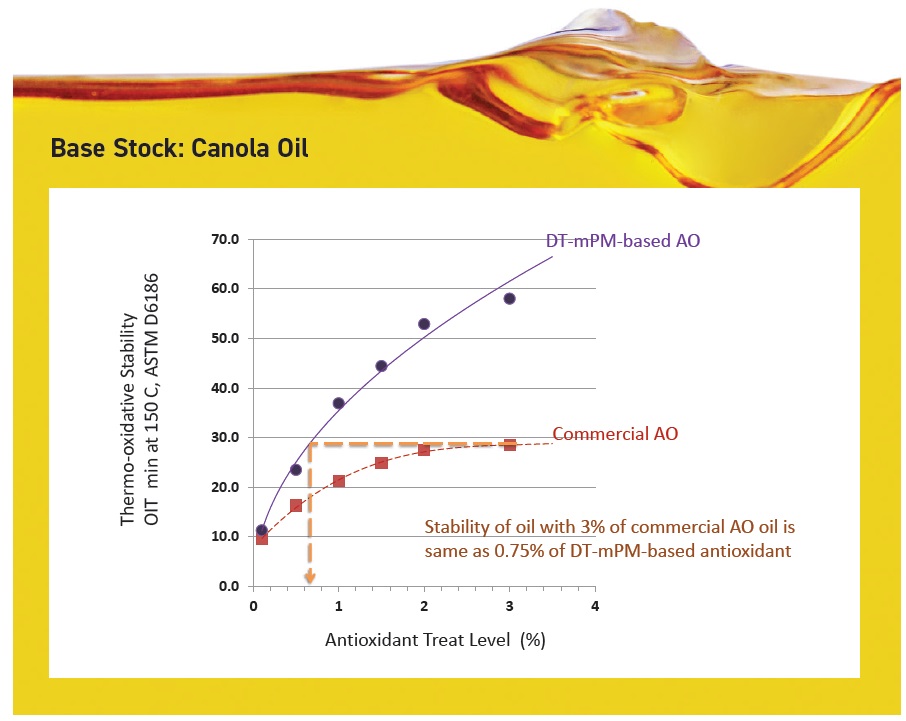 Figure 1. A pressure-differential scanning calorimetry test with canola oil shows that comparable performance can be realized when a DT-mPM-based antioxidant is used at a treat rate four times lower than a commercial antioxidant. (Figure courtesy of Polnox Corp.)
Figure 1. A pressure-differential scanning calorimetry test with canola oil shows that comparable performance can be realized when a DT-mPM-based antioxidant is used at a treat rate four times lower than a commercial antioxidant. (Figure courtesy of Polnox Corp.)
© Can Stock Photo / Naypong
Beaver in general feels that complying with government regulations is very challenging for environmentally friendly lubricant suppliers. He says, “Applications that involve governmental compliance (such as VGP, Ecolabel and OSPAR) and/or OEM approvals from equipment manufacturers are very challenging to meet. A clear understanding of the approval and compliance requirements is essential.”
Environmentally friendly lubricants have been developed that meet these regulatory requirements and display comparable performance to mineral oil-based fluids. For example, a hydraulic environmental PAO and related hydrocarbon product- (HEPR) based hydraulic fluid that is compliant with VGP exhibits superior results to a mineral oil-based hydraulic fluid as shown in Table 1.
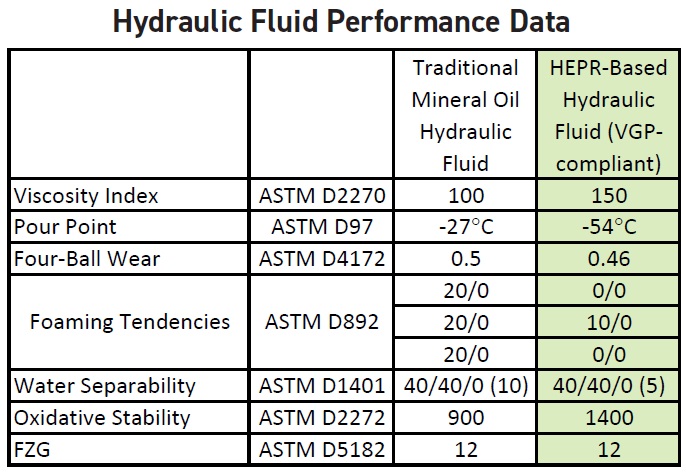 Table 1. A HEPR-based hydraulic fluid that is compliant with VGP displays superior performance to a traditional mineral oil-based hydraulic fluid. (Table courtesy of RSC Bio Solutions.)
Beneficial characteristics
Table 1. A HEPR-based hydraulic fluid that is compliant with VGP displays superior performance to a traditional mineral oil-based hydraulic fluid. (Table courtesy of RSC Bio Solutions.)
Beneficial characteristics
STLE-member Dr. Helen Ngo, research chemist with the USDA, gives the example of isostearic acid as an environmentally friendly lubricant additive. She says, “The most beneficial characteristic that additives can provide environmentally friendly lubricants are low toxicity and biodegradability. Isostearic acid is a unique saturated branched chain fatty acid that is used as a lubricant additive in high-end technical applications.
“This branched fatty acid has good cold flow temperature properties and excellent oxidative stability,” Ngo adds. “We have developed a highly efficient isomerization process to make the precursor, iso-oleic acid from fatty acid feedstocks (
2). Iso-oleic acid is then easily converted to isostearic acid by standard catalytic hydrogenation. Isostearic acid displays excellent stability, good viscosity index and excellent lubricity properties. This compound also has good degradation properties in the presence of microbes.” She indicates that ester derivatives of isostearic acid (such as the polyolester, trimethylolpropane triisostearate) can be used as boundary lubricity additives in lubricant applications.
Erhan believes that use of environmentally friendly lubricant additives provides a benefit because they are compatible with environmentally friendly lubricant base stocks. He says, “This is a typical example of ‘like dissolves in like.’ Higher-performing derivatives of triglycerides such as dimer acids, estolides fatty esters, heat bodied or blown oils all have very good solubility in vegetable oils. These derivatives will further enhance attributes such as forming thicker lubricant films, increase additive deposition, speed surface wetting, adding mobility to attached molecules that will enhance lubricity and filling asperities to provide exceptional lubrication under very heavy loads.”
Environmentally friendly lubricant additives also exhibit the versatility to be compatible with mineral oil base stocks and can contribute beneficial characteristics (
3). Figure 2 shows results from the ball wear produced in a high frequency reciprocating rig study where two polymeric vegetable oils (Additive-1 and Additive-2) are each added separately to mineral oil.
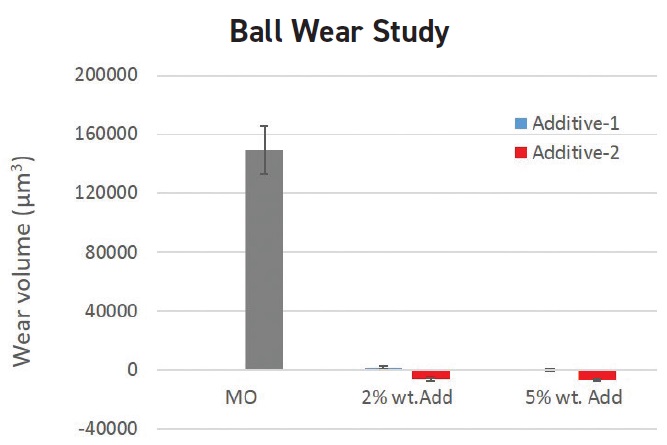 Figure 2. Introducing two environmentally friendly lubricant additives (Additive-1 and Additive-2) to mineral oil (MO) reduced the wear seen in a high frequency reciprocating rig study. (Figure courtesy of ADM and Argonne National Laboratory.)
Figure 2. Introducing two environmentally friendly lubricant additives (Additive-1 and Additive-2) to mineral oil (MO) reduced the wear seen in a high frequency reciprocating rig study. (Figure courtesy of ADM and Argonne National Laboratory.)
Erhan says, “In this study, lower molecular weight polymers (such as Additive-1) displayed better synergism with surface active components such as oleic acid and better surface coverage. On the other hand, higher molecular weight polymers (such as Additive-2) exhibited better antiwear characteristics.”
Vargo cautions that a formulator must consider the polarity of the additives with respect to the base oil. He says, “Vegetable oil has a high degree of polarity compared to mineral oils and PAOs. Additives with vastly different polarities than the base oil may not be compatible, which may lead them to drop out of solution over time.”
Base stock issues
Two of the main base stocks used in preparing environmentally friendly lubricants are vegetable oils and fatty esters. Both of them are vulnerable to hydrolysis during use, which can be particularly difficult in applications conducted in the marine environment.
Greaves says, “The rate of ester hydrolysis can increase when there is water contamination and is accelerated by acid, which is produced during aging of the product. We have found that superabsorbent polymers could be helpful in reducing ester hydrolysis (
4). Recently we reported that polyalkylene glycols (PAGs) known as triblocks show promise in helping to extend the life of esters when hydrolysis is a concern. The triblocks are prepared from blocks of oxyethylene and a block of oxypropylene.”
Figure 3 shows how these triblock polymers, when used as an additive, can exhibit swelling through hydrogen bonding of water molecules that bridge polymers to build viscosity that improves the ability of esters to resist hydrolysis.
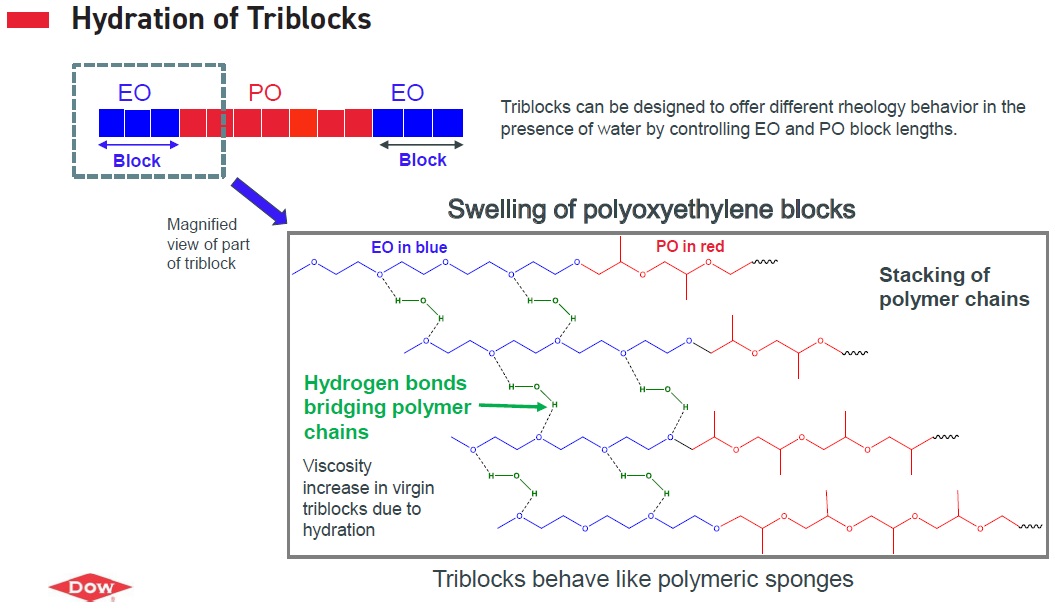 Figure 3. Hydrogen bonding of water molecules by PAG-based triblock polymers improves the hydrolytic stability of esters. (Figure courtesy of The Dow Chemical Co.)
Figure 3. Hydrogen bonding of water molecules by PAG-based triblock polymers improves the hydrolytic stability of esters. (Figure courtesy of The Dow Chemical Co.)
Hydrolysis also can be reduced by working with a renewable Group III+ base stock that is derived from natural sources. Vettel says, “We demonstrated the performance of this base stock in the ASTM D943 Wet Turbine Oil Oxidation Stability Test (TOST) using two different additive packages. Both additive packages are commercially available and differ in their use of different antioxidant components.”
Figure 4 shows that with both additive packages, the acid number stays fairly constant after more than 15,000 hours of testing.
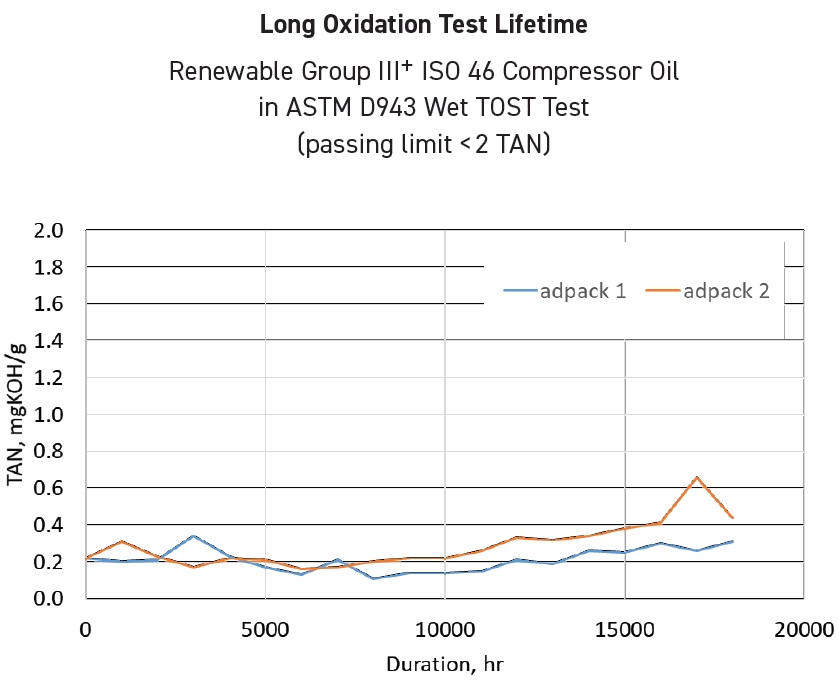 Figure 4. Use of two different commercially available antioxidant packages with a renewable Group III+ base stock leads to fairly constant acid numbers that exceed the passing limit after 15,000 hours of TOST testing. (Figure courtesy of Novvi LLC.)
Figure 4. Use of two different commercially available antioxidant packages with a renewable Group III+ base stock leads to fairly constant acid numbers that exceed the passing limit after 15,000 hours of TOST testing. (Figure courtesy of Novvi LLC.)
Vettel says, “We also have seen benefits with the renewable Group III+ base stock when used with a conventional GF-5 additive package due to its superior low temperature, low volatility compared to other Group III base stocks.”
Housel indicates that the base stock choice impacts the type of additives used. He says, “Formulation is always a matter of synergy. Vegetable oils occur in a narrow viscosity range and have naturally good lubricity and a high viscosity index. This base stock requires additives for thickening (biobased complex esters) and preservation to overcome poor oxidative and hydrolytic stability and low-temperature fluidity. Additives can only help so much in stabilizing vegetable oils, so they can only be used under mild operating conditions.”
Housel continues, “For more extreme cold- and high-temperature operating conditions, a different structure, synthetic ester technology, is required where glycerin is replaced with a synthetic neo-polyol and fatty acid chosen to build ideal lubricant molecules. Additives are used in combination with synthetic esters to upgrade their operating capabilities.”
Differences in base stock performance in a 75W90 synthetic gear oil are shown in the use of an all PAO formulation, four PAO-ester blends, a vegetable oil (canola oil) and a polyolester (TMP tricocoate). In Table 2, the base stocks were all formulated with a commercial gear oil additive package at a 2.3% treat rate. Superior performance was seen for the polyolester-based gear oil when evaluated using the Falex Pin and Vee Block instrument.
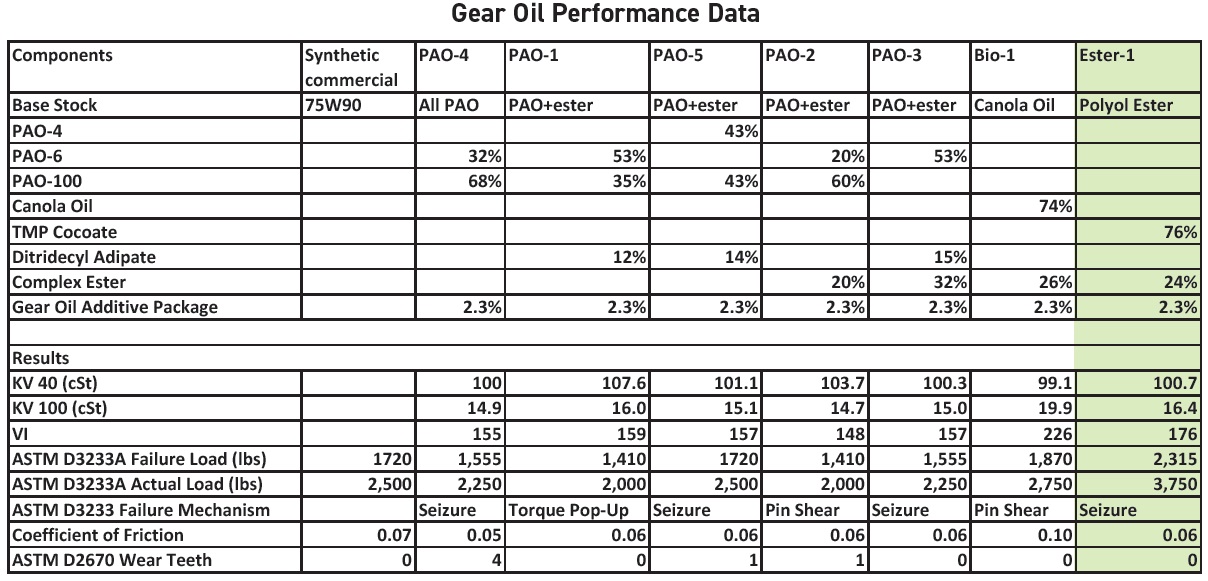 Table 2. In the gear oil study shown, the base stock selection dictated performance as shown from the results of five base stocks with the same commercial gear oil additive package. The polyolester-based gear oil displayed superior performance. (Table courtesy of Zschimmer & Schwarz and Functional Products, Inc.)
Table 2. In the gear oil study shown, the base stock selection dictated performance as shown from the results of five base stocks with the same commercial gear oil additive package. The polyolester-based gear oil displayed superior performance. (Table courtesy of Zschimmer & Schwarz and Functional Products, Inc.)
Levy says, “Each base stock class has different inherent properties and their strengths should be optimized while their weaknesses need to be addressed with additives or other base stocks. As an example, vegetable oils are not oxidatively stable and antioxidants need to be added to address their weaknesses, although they offer good lubricity, which means they do not require as high a treat rate of antiwear/EP additives as some other base stocks.”
New additive technologies
Hindered phenolics have been a key additive component used in automotive and industrial lubricants. They are produced through synthetic processes. Recently a new approach has been taken to develop phenolics from natural sources. Wagner says, “Poly-phenolic branched-chain fatty acids (
see Figure 5) have been prepared through the reaction of natural phenolics such as thymol and fatty acids (
5). Initial antioxidant testing is promising, although further work is needed. One advantage of the poly-phenolic branched-chain fatty acids is the fatty acid component is completely saturated.”
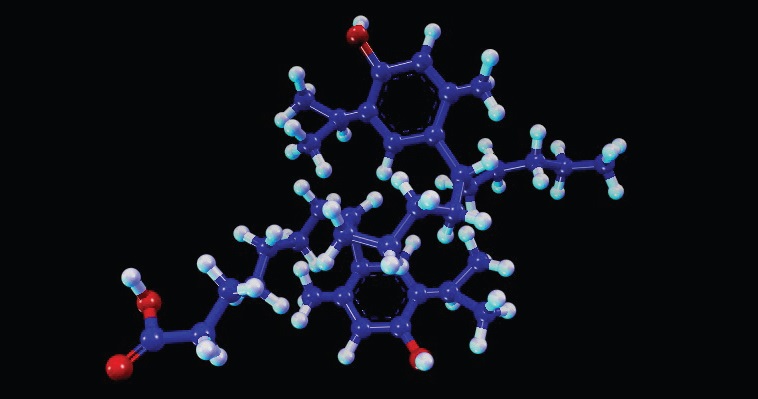 Figure 5. The proposed structure for a poly-phenolic branched-chain fatty acid is shown. (Figure courtesy of the USDA.)
Figure 5. The proposed structure for a poly-phenolic branched-chain fatty acid is shown. (Figure courtesy of the USDA.)
Another intriguing potential application for poly-phenolic branched-chain fatty acids is for use as a biocide in MWFs. Phenolics are used as biocides, and the branched nature of the fatty acids improves the bio-resistant characteristic of an additive. Wagner says, “Initial testing has shown that poly-phenolic branched chain-fatty acids exhibit antimicrobial properties in testing against the Gram-positive bacterium Listeria innocua. Further testing needs to be done with microbes present in MWFs.”
This type of technology might be useful because the MWF industry is faced with having fewer biocide options in the future. One other advantage of poly-phenolic branched-chain fatty acids is they are odorless in contrast to currently used phenolic derivatives.
Another source of environmentally friendly lubricants is from pine trees. Lignin is a readily available organic polymer and is the main structural component of wood. This natural material is isolated as a byproduct in the manufacture of paper.
Levy says, “A lignin-based additive (
6) has been developed that displays EP characteristics in greases (
see Figure 6). Four-ball EP and wear testing shown in Table 3 indicates that the lignin additive improves the performance of a base lithium thickened grease.”
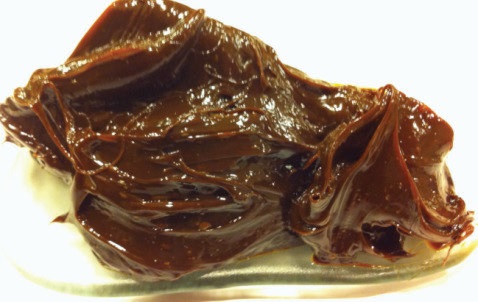 Figure 6. A grease formulated with a lignin-based EP additive. (Figure courtesy of Novitas Chem Solutions LLC.)
Figure 6. A grease formulated with a lignin-based EP additive. (Figure courtesy of Novitas Chem Solutions LLC.)
 Table 3. Four-ball EP and wear testing showed that better performance was achieved when a lignin-based EP additive was added to a base lithium thickened grease. (Table courtesy of Novitas Chem Solutions LLC.)
Table 3. Four-ball EP and wear testing showed that better performance was achieved when a lignin-based EP additive was added to a base lithium thickened grease. (Table courtesy of Novitas Chem Solutions LLC.)
A new corrosion inhibitor has been developed that is environmentally friendly and multi-functional. Cholli says, “This new technology platform has the potential to replace rust inhibitors, copper inhibitors and demulsifier additives. Replacing three additives with a single molecular entity helps formulators in reducing their costs and, more importantly, significantly reduces the total eco-toxicity of the finished lubricant. In a recent study comparing this environmentally friendly corrosion inhibitor with a commercial rust inhibitor at equivalent treat rates, the environmentally friendly corrosion inhibitor displayed superior performance under the guidelines of ASTM D665b, which uses sea water (
see Figure 7). No evidence of rust was seen when the 24-hour procedure was extended for one week.”
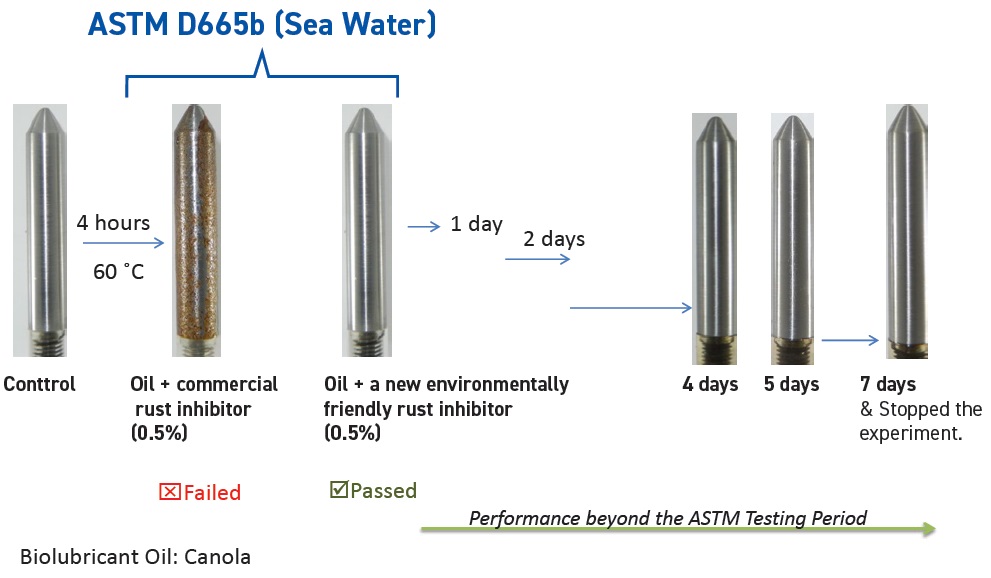 Figure 7. A newly developed, commercially available environmentally friendly corrosion inhibitor displays superior performance in the ASTM D665b test, which uses sea water compared to a commercially available corrosion inhibitor. (Figure courtesy of Polnox Corp.)
Figure 7. A newly developed, commercially available environmentally friendly corrosion inhibitor displays superior performance in the ASTM D665b test, which uses sea water compared to a commercially available corrosion inhibitor. (Figure courtesy of Polnox Corp.)
Cholli indicates that this corrosion inhibitor also displays other properties such as a 1a or 1b rating for the ASTM D130 copper strip test when run at 100 C for one week instead of the customary three-hour test procedure. The corrosion inhibitor exhibits a water separation capability (demulsification) rating of 40-40-0 (20) when evaluated using ASTM D1401 at 54 C.
Desired additive data and treat rate restrictions
Formulators of environmentally friendly lubricants will need additional data beyond performance in evaluating new additives. Beaver says, “Compliance and documentation regarding biodegradability, aquatic toxicity and bioaccumulation are three key issues. Data sets are needed from additive suppliers to support claims made to governing or approval bodies.”
Beaver continues, “Additive suppliers need to keep in mind that treat rates are set by independent governing bodies such as the EU Lubrication Substance Classification List (LuSC) and the CEFAS. Treat rates are often dictated by percent of renewable content requirements set by regulations such as VGP. If there are issues with treat rate, a tactic to use is to work with a less concentrated version of the additive at a higher treat rate.”
For Vettel, performance data is a priority followed by health and safety information. She says, “Performance data is needed first and foremost since the additive must supply needed performance to the lubricant. If the additive meets this criterion, then it must have an adequate health and environmental toxicity profile to meet restrictions in specifications such as Ecolabel.”
Gaining regulatory approval
With the significant number of regulatory approvals that manufacturers of environmentally lubricants may seek to build their businesses, insight on the nature of the additives they are using in their formulations is important. Greaves says, “Formulators need to be tuned into the changes in environmental specifications. The Ecolabel and VGP regulatory programs are scheduled for upgrades in the next year. These may include revisions to permitted additive treat levels and further restrictions on the use of additives considered to be hazardous. The Ecolabel requires some fluids to meet application performance specifications as well, which means that formulators will need to work closely with their additive suppliers to understand the efficiency performance of additives and also their environmental performance.”
Housel believes that the biobased percent targets for specific regulatory approvals will be used by formulators in designing their products. He says, “The Biopreferred and Ecolabel approvals are each dependent on use. For example, a multipurpose lubricant must be 88% biobased to qualify for the USDA Biopreferred certification while a straight oil MWF only needs 66% biobased content. Ecolabel works the same way. Each application has its own limits so the lubricant formulator must first determine the use and then build the formulation around that.”
Erhan states that use of environmentally friendly lubricant additives can only help the formulator meet the percent targets for specific applications. He says, “The percent targets are based on percentages in formulations. Use of the proper environmentally friendly lubricant additive will assist the formulator in passing the required minimums without compromising performance.”
Expectations
The movement to using environmentally friendly lubricant additives has been slow due to the need to identify the right technologies that not only meet specific applications but also regulatory guidelines. Each of the contributors was asked for input about the future and whether there will be growth in the use of this additive type.
Vargo says, “Environmentally friendly lubricant additives will become more available as the words green and renewable become more accepted and actually have a deeper meaning in today’s culture. Companies that sell finished environmentally friendly fluids will find it easier, more cost effective and actually a business grower to show that their products meet governmental regulations both domestically and abroad.”
Ngo says, “With the growing awareness and demand to use more environmentally safe products, we expect that more environmentally friendly lubricant additives will be available in the future to make it easier to formulate the finished lubricants. However, these future products will have to be price competitive and capable of overcoming the disadvantages that mineral oil-based lubricants have exhibited.”
Cholli says, “Investment in new and qualified environmentally friendly lubricant additives requires investment in R&D and time. Existing common and commoditized additives used today were developed sometime back for petroleum-based oils. Many of these additives may not meet today’s regulatory needs for environmentally friendly lubricants. We feel that committing to R&D is essential in developing new products that not only meet today’s needs but are able to meet the more challenging operating environments and regulatory standards in the future.”
Erhan says, “The requirements for lubricants and additives are rapidly changing due to advances in technology and new information. These changes stem from various sources such as advances in machines with faster speeds, higher pressures and development of newer and more efficient alloys that bring strength and light weight but also are harder to machine or have lost some of their natural lubrication. New concerns generated from advances in health-related information also will lead to the need for new additive technologies.”
Erhan continues, “Environmentally friendly lubricant additives should be able to grow in use to meet both performance and regulatory drivers. We believe that vegetable oils are very effective in meeting new requirements. Though lacking certain key properties such as oxidation resistance, higher functioning derivatives of vegetable oils may provide ideal solutions for new lubricant requirements at lower costs. This should enable formulators to have a win-win situation where these derivatives will maintain a high level of biodegradability and no toxicity while delivering at the same time very high performance.”
Housel is optimistic about the future of environmentally friendly lubricant additives. He says, “This is an active area of research, particularly in academia, and I expect that new additives will continue to be developed.”
Beaver draws a distinction between marine and all other applications in predicting the future. He says, “For marine use, we expect exponential growth in the use of environmentally acceptable lubricants over the next 10 years. With fewer regulatory drivers, we see slower growth in land-based applications. That being said, many industrial companies are looking for ways to reduce total cost of operation. Environmentally acceptable lubricants that can extend fluid life and perform equal to or better than a mineral oil are being considered equally in synthetic product lines because they can claim green operations.”
Vettel says, “Lack of adequate performance has hindered the use of environmentally friendly lubricants in the past. The lubricant industry now has base stocks and additives that exhibit high technical performance in addition to meeting the environmental specifications. This will enable the use of environmentally friendly lubricants to grow.”
Use of environmentally friendly lubricant additives continues to grow as their performance characteristics enable them to be used in today’s high performance, demanding applications. But their future may still be dependent upon how rapidly governmental regulations globally take hold to persuade end-users to work with them.
REFERENCES
1.
For more information on the European Union Ecolabel program, please click
here. For more information on the USDA’s Biopreferred program, please click
here.
2.
Ngo, H. and Foglia, T. (2015), “Process for Preparing Saturated Branched Chain Fatty Acids,”
US Patent 9,115,076 B2.
3.
Lorenzo-Martin, C., Ajayi, O. and Erhan, S., “Evaluation of Friction and Wear Behavior of Bio-Derived Performance Additives,” Presented at the 73rd STLE Annual Meeting in Minneapolis, Minn., on May 23, 2018.
4.
Canter, N. (2017), “PAGs: Reducing ester vulnerability to hydrolysis,” TLT,
73 (10), pp. 10-11.
5.
Ngo, H., Fan, X. and Moreau, R. (2018), “Poly-phenolic branched-chain fatty acids as potential bio-based, odorless, liquid antimicrobial agents,”
INFORM,
29 (3), pp. 20-22.
6.
Canter, N. (2010), “Environmentally friendly extreme pressure additive,” TLT,
67 (10), pp 10-11.
Neil Canter heads his own consulting company, Chemical Solutions, in Willow Grove, Pa. Ideas for Tech Beat items can be sent to him at neilcanter@comcast.net.